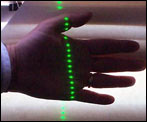

 February 2, 2004, written by Holli Riebeek, design by Goran Halusa |
|||
|
Three days after Hurricane Isabel thrashed the North Carolina coast, Wayne
Wright took his twin-engine Cessna 310 to the skies. Flying just 300 meters above
the islands of the Outer Banks, he and his team bounced a green laser across the
landscape, tracing the contours of the beaches to build a picture of how the land
had changed. Sand dunes were missing and a new inlet was gouged across Hatteras
Island. They took millions of measurements and over 30,000 pictures that will
help geologists understand how extreme events, such as hurricanes, shape our
coast. |
|
||
|
|
Water washes through a newly formed breach on Hatteras Island, North Carolina, a few days after Hurricane Isabel swept through the area. Image courtesy of Asbury Sallenger and Amar Nayegandhi, USGS Center for Coastal and Watershed Studies. |
||
|
Wright is the lead investigator for NASA’s Experimental Advanced Airborne Research
Lidar (EAARL) system at Wallops Flight Facility on Virginia’s eastern shore. He
is collaborating with Asbury Sallenger, Jr., a research oceanographer at the US
Geological Survey in St. Petersburg, Florida, to determine how much damage Hurricane
Isabel inflicted on US beaches. At other times, Wright has used EAARL to map shallow
coral reefs, chart the invasion of foreign plants, and map shallow Midwest river
bottoms. |
|||
|
Their primary tool is a lidar, which is short for Light Detection and Ranging. Lidar works like radar, but uses light waves instead of radio waves to measure the distance to objects. Typical mapping lidar systems bounce a laser light pulse off a surface and record the time it takes for the light to return to determine the distance it traveled. Plants, water, bare exposed earth, and the bottom of a shallow sea each absorb and reflect different colors (wavelengths) of light in different ways. Most lidars are optimized to map one or two types of surface terrain because vastly different lasers and laser receivers are required for, say, bare earth compared to plant cover. EAARL is distinct in that it can trace out the topography of bare ground under vegetation, map out the vegetation itself, and, where the water is clear enough, measure the depth and clarity of the water as well as the shape of underwater surfaces. “EAARL is uniquely able to make measurements over ground that varies tremendously in reflectivity and complexity,” says Wright. “We could fly over water, and one pulse could fall in the water and the next on a sandy beach.” Water, Wright explains, tends to absorb the light and return a much weaker signal, while exposed sand is highly reflective and vegetation falls somewhere in between. “Other [lidars] tune for either weak or strong signals,” Wright says. But EAARL can capture them all because it makes frequent measurements – about four billion per second using multiple detectors. This trait makes it perfect for tracking hurricane damage in coastal areas, which are made up of water, sand and plant life. EAARL’s flexibility gives it another advantage for charting storm damage. Because it is already designed to measure all sorts of terrain, it can be kept on a dedicated airplane, ready to go at almost any time. It doesn’t have to be re-calibrated for every project and every sort of terrain. “EAARL was on standby. It works on short notice,” says Sallenger, and for his beach mapping project, time was in short supply. |

Green points of light from EAARL’s laser track across Wayne Wright’s hand. Image courtesy of the U.S. Geological Survey web site. |
||
| |
|||